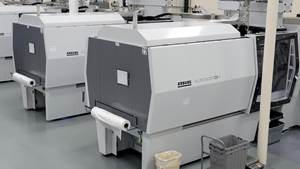More Complexity Adds Costs And Opportunities in Medical
Wood on Plastics
The rapidly rising cost of healthcare will generate demand for products that lower these costs to consumers. There are several ways that plastics can achieve these kinds of savings.
If I ever become famous enough to have a principle of economics named for me in the textbooks (i.e. Wood’s Rule), then I would like it to be this: No problem in economics ever becomes easier to solve by adding more people. This is because people are inherently complex and often unpredictable organisms, and adding more of them to the equation only increases the difficulty of finding a solution...along with raising the cost involved.
Nowhere will this rule prove more true than in the medical industry. As we all know by now, the market for medical products will be significantly affected for the foreseeable future by the Affordable Care Act (ACA or Obamacare). The rich political irony of the ACA is that its name includes the word “affordable,” but the real thrust of the law is to expand access to healthcare—not necessarily make it less expensive.
This is good news for manufacturers of plastics medical products: The rapidly rising cost of healthcare will generate demand for products that lower these costs to consumers. There are several ways that plastics can achieve these kinds of savings, and almost all of the savings will stem from the fact that these products add simplicity to the highly complex problem of keeping Americans healthy.
For instance, one significant method that insurers will utilize to lower healthcare costs is to reduce the amount of time patients spend in the hospital. This means that an increasing amount of inpatient healthcare will shift to home treatment. Many types of medical equipment and supplies will likely be sold directly to consumers through retail outlets in much the same way that prescription drugs are now. This will also spur demand for new, low-cost devices that monitor and communicate medical information between patients at home and doctors in the hospital.
Another way that future costs will be contained is by reusing or recycling medical supplies and equipment. A large percentage of the plastic supplies that are currently sold to healthcare providers are considered disposable. But resin prices are rising, and so are disposal costs. Many plastic products can be redesigned so they can be sterilized and used multiple times or integrated into the recycling stream.
The increased complexity and overall activity levels that stem from integrating all of these new patients/customers into the marketplace for medical products will keep a high premium on new technical innovations. New products will be invented, and improved ways of manufacturing existing products out of cheaper or more durable or lighter-weight materials will be developed.
Ultimately, the very best way to lower healthcare costs is to eliminate the need for them. Because let’s face it, the vast majority of what we have been talking about here are not really healthcare costs but rather “sick care” costs. Products that keep Americans healthy and productive throughout their lives will ultimately prove far less expensive than trying to fund and administer programs that pay for all of their medical care once they reach the age of 65. This is the corollary to Wood’s Rule: Economic problems are easier to solve if you subtract people. Less complexity, lower costs, and a healthier populace—those are the kind of products I want.
WHAT THIS MEANS TO YOU
•Hospitals are becoming increasingly “green,” and some plastics are perceived as less “green” than others (i.e. PVC). So be prepared for some de-selection of certain products.
•Certain aesthetic qualities of medical products (color, texture, etc.) will gain importance as more products are sold directly to consumers.
•The volume of healthcare products shipped to consumers is rising, and this will increasingly affect how they are packaged.
Related Content
Arterex Acquires Italian Medical Device Provider
Arterex’s acquisition of Phoenix S.r.l. continues its growth mission to offer customers in North America and Europe diversified, high-precision medical device manufacturing solutions.
Read MoreMedical and Molding Elite
When Jeff Smith received a notice evicting his promising 911爆料网 out of his house, it could have been the end of Elite Biomedical Solutions’ and Elite Precision Plastics’ stories before they really got started, instead it was just the beginning.
Read MoreMedical Tubing: Use Simulation to Troubleshoot, Optimize Processing & Dies
Extrusion simulations can be useful in anticipating issues and running “what-if” scenarios to size extruders and design dies for extrusion projects. It should be used at early stages of any project to avoid trial and error and remaking tooling.
Read MoreConsistent Shots for Consistent Shots
An integral supplier in the effort to fast-track COVID-19 vaccine deployment, Retractable Technologies turned to Arburg and its PressurePilot technology to help deliver more than 500 million syringes during the pandemic.
Read MoreRead Next
Beyond Prototypes: 8 Ways the Plastics Industry Is Using 3D Printing
Plastics processors are finding applications for 3D printing around the plant and across the supply chain. Here are 8 examples to look for at NPE2024.
Read MoreLead the Conversation, Change the Conversation
Coverage of single-use plastics can be both misleading and demoralizing. Here are 10 tips for changing the perception of the plastics industry at your company and in your community.
Read MoreMaking the Circular Economy a Reality
Driven by brand owner demands and new worldwide legislation, the entire supply chain is working toward the shift to circularity, with some evidence the circular economy has already begun.
Read More









